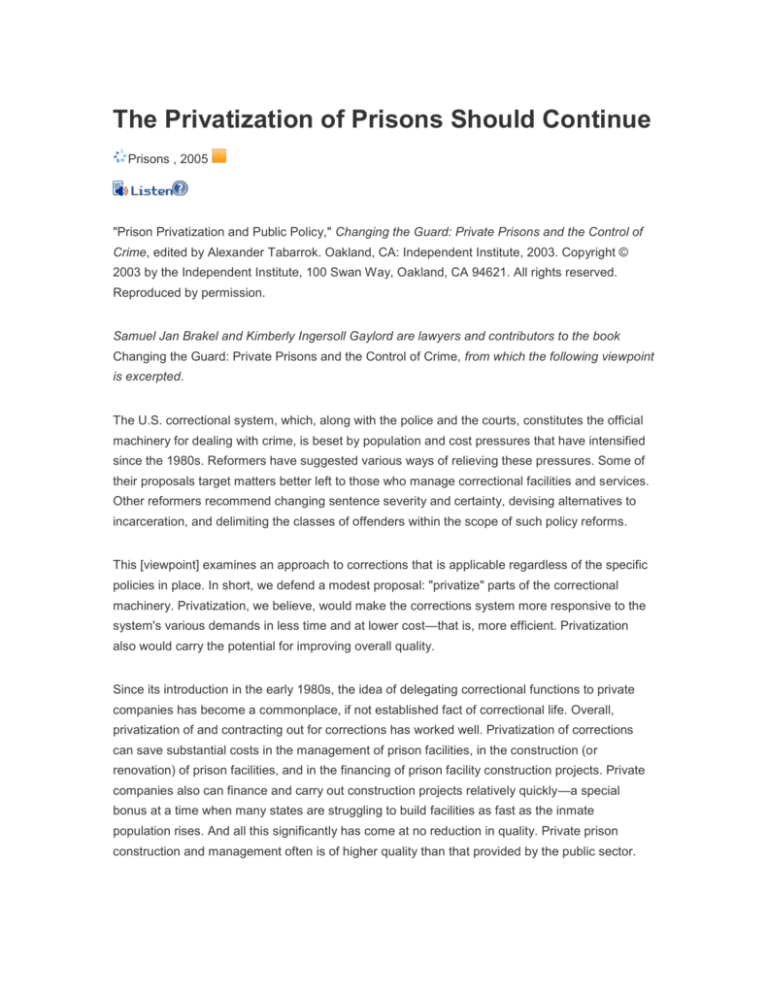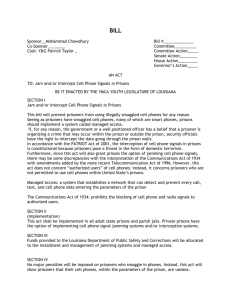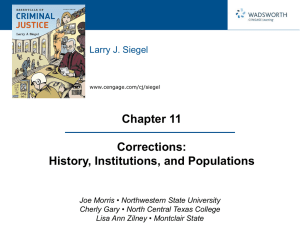
The Privatization of Prisons Should Continue
Prisons , 2005
"Prison Privatization and Public Policy," Changing the Guard: Private Prisons and the Control of
Crime, edited by Alexander Tabarrok. Oakland, CA: Independent Institute, 2003. Copyright ©
2003 by the Independent Institute, 100 Swan Way, Oakland, CA 94621. All rights reserved.
Reproduced by permission.
Samuel Jan Brakel and Kimberly Ingersoll Gaylord are lawyers and contributors to the book
Changing the Guard: Private Prisons and the Control of Crime, from which the following viewpoint
is excerpted.
The U.S. correctional system, which, along with the police and the courts, constitutes the official
machinery for dealing with crime, is beset by population and cost pressures that have intensified
since the 1980s. Reformers have suggested various ways of relieving these pressures. Some of
their proposals target matters better left to those who manage correctional facilities and services.
Other reformers recommend changing sentence severity and certainty, devising alternatives to
incarceration, and delimiting the classes of offenders within the scope of such policy reforms.
This [viewpoint] examines an approach to corrections that is applicable regardless of the specific
policies in place. In short, we defend a modest proposal: "privatize" parts of the correctional
machinery. Privatization, we believe, would make the corrections system more responsive to the
system's various demands in less time and at lower cost—that is, more efficient. Privatization
also would carry the potential for improving overall quality.
Since its introduction in the early 1980s, the idea of delegating correctional functions to private
companies has become a commonplace, if not established fact of correctional life. Overall,
privatization of and contracting out for corrections has worked well. Privatization of corrections
can save substantial costs in the management of prison facilities, in the construction (or
renovation) of prison facilities, and in the financing of prison facility construction projects. Private
companies also can finance and carry out construction projects relatively quickly—a special
bonus at a time when many states are struggling to build facilities as fast as the inmate
population rises. And all this significantly has come at no reduction in quality. Private prison
construction and management often is of higher quality than that provided by the public sector.
Despite the evidence for these claims, there remains strong opposition to the concept of
privatizing corrections. Some of this opposition stems from a philosophic position that holds it to
be "just plain wrong." Sometimes the opposition is articulated in terms of legal concerns, other
times in symbolic imagery ("Do we want to put inmates at the mercy of the ACME Correctional
Company?"). Some opposition reflects pure self-interest. For example, public-employee unions
are among the most vocal critics because they fear union members will lose their jobs.
Much of this opposition is ill founded. Although unions in some states (e.g., Illinois and New York)
have effected the passage of statutes prohibiting contracting out with private corrections
companies, there are no principled legal arguments to support this selective curtailment of the
delegation of authority. Arguments base on governmental philosophy merely substitute
preconceived opinion for analysis, and the symbolic objections misperceive both the central
social and economic experience of our country and public attitudes toward government....
The National Problem
The "generic" problems facing corrections systems nationwide are overpopulation and rising
costs. Many of the nation's systems are in crisis, although a few states have escaped these
deleterious trends.
The 1990s saw a continuation of the steep rise nationwide, which began in the 1970s, in the total
number and percentage of adults on probation, in jail or prison, or on parole. In 1990, 4,348,000
adults were under some form of correctional supervision. By mid-2000, that number had risen to
6,467,200—a 48.7 percent increase.
The adult prison population (i.e., convicted offenders)—traditionally the target of the bulk of the
correctional system's efforts and resources—increased, along with the more comprehensively
defined correctional population (all those under correctional control, including probationers,
parolees, and jail detainees)....
Large, systemic problems require large, systematic solutions. The solution we propose, which
represents only one of several possible (not mutually exclusive) modes of attack, is privatization.
We recommend not a precipitous, wholesale divestment of the state's responsibility for
correctional facilities and services, but a more gradual, quasi-experimental approach. Each state
should consider, as an initial step, privatized management of at least three facilities, according to
size and security, that roughly represent the range of adult correctional experiences in that state.
When possible, the states would distribute the initial privatization contracts in such a way as to
permit performance comparisons between similar institutions. For example, a state with two highpopulation prisons might privatize one and compare its performance with the publicly managed
prison. Similarly, if a state needs new prisons, it might contract out the construction of one prison
to a private contractor, who also would be responsible for arranging its financing.
The objective is to implement privatization in a way that will allow the states to learn from the
experience. The idea is to introduce competitive forces into the current correctional statemonopoly environment to test the effectiveness both of the states' traditional "public" efforts and
of the private prison-service providers. The ultimate goal is to build a competitive partnership
between the state and private enterprise rather than simply to hand over corrections to the forces
of the market....
Potential and Proven Benefits of Privatized
Corrections
Few would argue that incarcerating and trying to rehabilitate offenders convicted by the state is
not the business of government; there is no compelling philosophic argument for government to
divest itself of this responsibility and its burdens. The issue is instead pragmatic: What is the
optimum way to discharge this responsibility?
Private firms must keep costs low and quality high or else their profits will fall, their customers will
leave, and if the problems are not fixed in time, they will go bankrupt. The theory that competition
and the profit incentive enhance efficiency has been tested in countless and varied settings
wherein public and private operations have been compared. It would be surprising if corrections
were different, but empirical investigation is warranted still, and we must also ask whether
noneconomic costs render privatization prohibitive irrespective of efficiency gains.
Costs must be considered regarding three aspects of corrections operations: (1) the construction
(or renovation) of facilities; (2) the management of facilities and programs; and (3) the costs of
financing construction projects.
By contracting out to private vendors, at least in the short term, states can guarantee themselves
cost savings in all three areas, because, in the tradition of governments' contracting with private
parties for correctional services, contracts can be approved only if they save the government
money. In an era when companies are still trying to get a foothold in the market, they are willing
to take initial losses. Therefore, governments are able to obtain contractually favorable costs
terms, irrespective of the long-term viability of these terms to the vendor.
However, it would be shortsighted for governments to embark upon a privatization course if there
were no prospects for long-range viability. If the terms are not lastingly viable, the vendor will
withdraw prior to or upon contract expiration. The state may be able to get another vendor willing
to play the loss-leader game, but the process is sustainable only for a limited period. Thus, longterm viability on costs is ultimately in both parties' interest.
After almost three decades of experience with privatized corrections, there is strong evidence that
the cost savings are both substantial and sustainable....
The Quality of Private-Prison Management
Even many opponents of private prisons concede that privatization may save the state some
money, but they perceive the correctional enterprise as a zero-sum game—if costs are falling,
then quality must be falling also. Yet this perception is contradicted by the facts.
One of the writers of this [viewpoint] (Brakel) conducted one of the earliest studies on the quality
of private prisons. The [1988] study focused on the ... Silverdale facility near Chattanooga,
Tennessee. In an examination of sixteen major aspects of prison conditions and procedures,
Brakel concluded that the takeover of the prison by the private vendor CCA [Corrections
Corporation of America] had resulted in substantial gains in the following areas: (1) the physical
plant, including its general upkeep and cleanliness; (2) safety and security, in particular improved
prisoner classification; (3) staff professionalism and treatment of inmates; (4) medical services;
(5) recreation programs and facilities; (6) religious and other counseling services; (7) disciplinary
procedures; (8) inmate grievance and request procedures; and (9) legal access. In the remaining
areas, CCA's performance was roughly equivalent to the country's performance, but in no area
was a diminution in quality found.
Brakel pointed out that the improvements achieved by CCA came in a setting where a great deal
of improvement was needed. The county's own management record contained many glaring
deficiencies, a fact that figured heavily in the county commissioners' decision to go private in the
first place. From one perspective, these prior deficiencies might appear to diminish the
significance of CCA's accomplishments. On the other hand, they might be interpreted to augment
those accomplishments. The company was dealt a difficult hand at Silverdale: a dilapidated
facility with long-standing management problems, situated in a resource-poor environment,
contracted out at a per diem fee rate that left the private provider only the slimmest possible profit
margin. The fact that the company was able, against these odds, to achieve overall institutional
respectability within two and one-half years of the takeover can be viewed as strong evidence of
the private sector's capacity to contribute to quality prison management.
C. Logan conducted a more recent study of private-prison management in 1990-91. Already
mentioned in reference to the cost issue, this investigation involved a 200-bed, multi-security-
level facility in New Mexico for the state's entire population of sentenced women felons. The now
familiar CCA managed the prison beginning in 1989 and built the physical plant.
With more detail than the Silverdale analysis, Logan measured management quality in eight
standard "dimensions"—security, safety, order, care, activity, justice, conditions, and
management. Each of these dimensions in turn was broken down into more specific components,
yielding a total of 333 quality "indicators." Logan compared the results of the CCA management
experience for the first six months (June-November 1989) against the state-operated situation
one year earlier (June-November 1988.) In addition, he threw in a third point of comparison by
replicating the investigation in a federal women's prison at Alderson, West Virginia.
The analysis presents rich reading and is recommended to anyone who is interested in the
subject of prison privatization. For our purpose, however, the main conclusion offered in the
study's summary will suffice: "While all three prisons are regarded as having been high in quality,
the private prison outperformed its governmental counterparts on nearly every dimension."
Many other studies of the quality of private prisons have been performed. In Great Britain, the
director general of Her Majesty's Prison Services concluded after one study that the private
prisons "are the most progressive in the country at controlling bullying, health care, and suicide
prevention." The director general then took steps to see that the public prisons emulated the
techniques of the private prisons. Surveys of prisoners also find that prisoners prefer private
prisons because they are cleaner, health care is better, staff use force less often, and, perhaps
most important, violence among prisoners is better controlled.
Security Issues
Prison escapes are rare events in public or private prisons. Despite the occasional
sensationalistic media account, there is no evidence that escapes are more common in private
than in public prisons. Given the high costs of bad publicity to a private prison from an escape,
one would expect that, if anything, the rate of escape from private prisons would be lower than
the rate of escape from public prisons.
The charge has long been leveled that private corrections companies are willing and able to take
on management responsibilities only in relatively low-security settings. The implications are (1)
they lack "true" corrections experience and therefore will fall short if they undertake the
management of a high-security ("real") prison; and (2) they are cream-skimming by taking on the
"easy" populations in an effort to look good in comparison to public corrections agencies which
must deal with both nonviolent and hardened offenders funneled to them by the courts.
These charges are false. In the very early years of privatization, some states (for example,
Kentucky) limited private prisons to minimum-security prisoners. Today, however, the most
common class of prisoner one finds in privatized facilities are medium-security prisoners, and the
housing of maximum-security prisoners in private jails and prisons is not uncommon....
The Morality Issue
In some circles there remains opposition to prison privatization on the ground that the
incarceration of offenders convicted by the state is a uniquely governmental function whose
delegation to nongovernment entities is "just not right." This view is often stated more
pejoratively, particularly in relation to vendors who are in the business to make a profit. "Making a
buck off the backs of prisoners" is the phrase used to describe the presumably unseemly
character of this business.
Although this position has some intuitive appeal, if judging only from how frequently it is parroted
by privatization opponents, it does not stand up well to more-reasoned analysis. The mistrust of
the profit motive seems distinctly out of place in a society whose social and economic engines are
driven largely by this motive—indeed, whose creative (and moral) strength is believed to be a
very function of this motive, collectively and individually. In addition, the notion that the quest for
profit is somehow "worse" than competing motivations, such as power or convenience (to name
two that have considerable currency in the public and in other nonprofit settings), remains to be
explained. Last, it might be asked what the critical difference is between rewards paid out in
salaries as opposed to dividends ("profits"), not to mention that all those who work for profitmaking companies—in prisons, everyone from the warden on down to the line guards—are
virtually salaried employees.
There is yet the matter of symbolism that causes resistance to prison privatization. [Ira] Robbins,
the ABA [American Bar Association] reporter, has written derisively of prison guards with the logo
"ACME Prisons" on their uniforms. [John] Donahue and [John] DiIulio have invoked the White
House/President analogy to illustrate what they see as the moral or symbolic bankruptcy in the
idea of privatizing corrections. Donahue posits the "who should paint the White House versus
who should guard the President" dichotomy, finding it self-evident that the former is a job for
private business, whereas the latter is a function to be performed by public servants. DiIulio
paints a rent-a-President scene in which an actor "President" plus an entourage of musicians and
dignitaries of the "Medals Corporation of America" play out on the White House lawn the role of
giving out the National Medal of Honor to deserving citizens. According to DiIulio, it is clear that
such a scenario would not satisfy us. The appeal is primarily to our moral intuition, though
Donahue brings in the complexity of the guard-the-President task as among the more concrete
reasons for having a public Secret Service rather than a private protective force.
Satisfied Prisoners
However, the message of these illustrations is not nearly so self-evident as their creators think.
The question that might be posed in response to Robbins' ACME illustration is whether citizens
necessarily find the private-sector identification less appropriate or less confidence inspiring than
the public-sector identification, even for traditionally "public" services. Does the Federal Express
or United Parcel Service logo suggest to the average consumer a performance quality that is in
any way inferior to that of the U.S. Postal Services? To the DiIulio rent-a-President example the
response should be: let the President or other public officials do the symbolic acts, while private
providers do the real work. The answer to Donahue's complexity argument is a rhetorical
question: Is the public sector or the private sector better at handling complex, responsibility-laden
tasks? If one thinks of the air-transport industry, the utility of government oversight might
generate some consensus, but surely there is no call in this country today for the government
actually to "be" in the airline business. Rationally functioning partnership between government
and private vendors is what the prison privatization idea is all about. Opponents of the idea might
be less resistant if they thought in more limited terms, instead of in all-or-nothing, moral, and
symbolic propositions.
Perhaps the final find most persuasive response to the moral and symbolic concerns about prison
privatization is the evidence that the prisoners themselves do not share these concerns. The
Silverdale study, one of whose main investigatory components was a survey of inmate views,
showed that the prisoners' dominant concern was whether they were treated fairly and lawfully.
Precisely where the ultimate authority of their keepers resided or what logo was on the staff's
uniforms mattered little to them. They had no beef with privatization at Silverdale because they
were treated no worse and, in several respects, were treated better than they were led to expect
from their experience in the same facility under public management or from their experience in
other public facilities. There exists no plausible theory why "private" managers of prisons or their
staff would treat inmates worse than their public counterparts: the motivations are to the contrary
(mistreatment fosters discontent, lawsuits, riots, and so on), and the empirical evidence provided
by the inmates themselves clearly confirms this conclusion.









